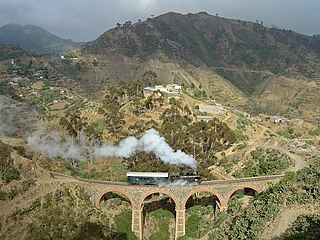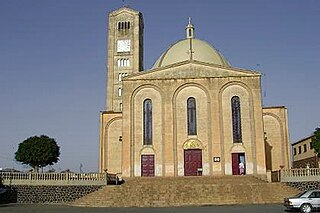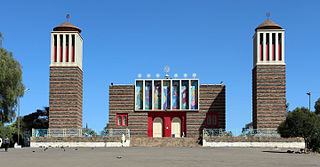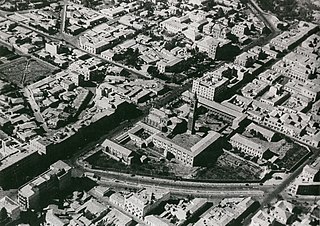
The Asmara President's Office is the building, in Italian neoclassical style, where the President of Eritrea lives and rules the country.

The Asmara President's Office is the building, in Italian neoclassical style, where the President of Eritrea lives and rules the country.
The former Italian government's palace was built in 1897 by Ferdinando Martini, the first Italian governor of Eritrea. The Italian government wanted to create in Asmara (just made capital of Eritrea in substitution of Massawa [1] ) an impressive building, from where the Italian Governors could show the dedication of the Kingdom of Italy to the "Colonia primogenita" (first daughter-colony) as Eritrea was called. [2]
During the Italian Empire the building was improved as the center of the "Governatorato dell'Eritrea"; it was heavily damaged during World War II and then converted into a National Museum by the Ethiopian authorities in the 1950s.
Today, it is the office of the President of Eritrea, Isaias Afewerki.
Governor Ferdinando Martini wanted a structure with colonnades at the entrance in neoclassical style, surrounded by a park with lush vegetation. In his opinion the building would be the biggest and most beautiful in Asmara, the newly declared capital of the Italian colony in 1897.
The interior was decorated with Italian marble and furniture brought from Italy and France. The main hall was decorated with typical Renaissance stairs toward the projected second floor. The main doors were specially crafted with wood from Brazil.
"Eritrea" is an ancient name, associated in the past with its Greek form Erythraia, Ἐρυθραία, and its derived Latin form Erythræa. This name relates to that of the Red Sea, then called the Erythræan Sea, from the Greek for "red", ἐρυθρός, erythros. The Italians created the colony of Eritrea in the 19th century around Asmara, and named it with its current name. After World War II Eritrea was annexed to Ethiopia. In 1991 the communist Ethiopian government was toppled by Eritrean forces and they earned their independence. Eritrea officially celebrated its 1st anniversary of independence on April 27, 1994.

Asmara, or Asmera, is the capital and most populous city of Eritrea, in the country's Central Region. It sits at an elevation of 2,325 metres (7,628 ft), making it the sixth highest capital in the world by altitude. The city is located at the tip of an escarpment that is both the northwestern edge of the Eritrean Highlands and the Great Rift Valley in neighbouring Ethiopia. In 2017, the city was declared as a UNESCO World Heritage Site for its well-preserved modernist architecture. Asmera was first settled in 800 BC with a population ranging from 100 to 1000. The city was then founded in the 12th century AD after four separate villages unified to live together peacefully after long periods of conflict.Under Italian rule the city of Asmara was made capital of Eritrea in the last years of the 19th century.

The Eritrean Railway is the only railway system in Eritrea. It was constructed between 1887 and 1932 during the Italian Eritrea colony and connects the port of Massawa with Asmara. Originally it also connected to Bishia. The line was partly damaged by warfare in subsequent decades, but was rebuilt in the 1990s. Vintage equipment is still used on the line.

Massawa, or Mitsiwa, is a port city in the Semienawi Keyih Bahri Region of Eritrea, located on the Red Sea at the northern end of the Gulf of Zula beside the Dahlak Archipelago. It has represented a historically important port for many centuries.

The Fiat Tagliero Building in Asmara, capital city of Eritrea, is a Futurist-style service station completed in 1938 and designed by the Italian engineer Giuseppe Pettazzi.

Education in Eritrea is officially compulsory between 7 and 16 years of age. Important goals of Eritrea's educational policy are to provide basic education in each of Eritrea's mother tongues as well as to produce a society that is equipped with the necessary skills to function with a culture of self-reliance in the modern economy. The education infrastructure is currently inadequate to meet these needs.

The Cinema Impero is an Art Deco-style cinema in Asmara, the capital of Eritrea. It was built in 1937 by the colonial authorities in Italian Eritrea.

The Governor's Palace is the city hall of Asmara, Eritrea. It was built during the colonial period in the city centre, in an Italian Art-Deco style.

The Church of Our Lady of the Rosary, Asmara is a Roman Catholic church built in the early 1920s in Asmara, when the city was the capital of Italian Eritrea. Often called "the cathedral", it is a large Lombard Romanesque style church in the centre of the city, built in 1923 to serve as the principal church of the Apostolic Vicariate of Eritrea.

The National Museum of Eritrea is a national museum in Asmara, Eritrea. Established in 1992 by Woldeab Woldemariam, it was originally located in the former Governor's Palace until 1997, when it was moved. The venue has since been relocated to the former Comboni Sisters School for Women.
Articles related to Eritrea include:

Eritrea, officially the State of Eritrea, is a country in Eastern Africa, with its capital at Asmara. It is bordered by Ethiopia in the south, Sudan in the west, and Djibouti in the southeast. The northeastern and eastern parts of Eritrea have an extensive coastline along the Red Sea. The nation has a total area of approximately 117,600 km2 (45,406 sq mi), and includes the Dahlak Archipelago and several of the Hanish Islands.

Italian Eritreans are Eritrean-born descendants of Italian settlers as well as Italian long-term residents in Eritrea.

Italian Eritrea was a colony of the Kingdom of Italy in the territory of present-day Eritrea. The first Italian establishment in the area was the purchase of Assab by the Rubattino Shipping Company in 1869, which came under government control in 1882. Occupation of Massawa in 1885 and the subsequent expansion of territory would gradually engulf the region and in 1889 borders with the Ethiopian Empire were defined in the Treaty of Wuchale. In 1890 the Colony of Eritrea was officially founded.

Eritrea Governorate was one of the six governorates of Italian East Africa. Its capital was Asmara. It was formed from the previously separate colony of Italian Eritrea, that was enlarged with parts of the conquered Ethiopian Empire following the Second Italo-Ethiopian War.

The Eritrean Catholic Archeparchy of Asmara, officially the Archeparchy of Asmara, more informally Asmara of the Eritreans, is the metropolitan see of the Metropolitan Eritrean Catholic Church, a sui iuris Eastern Catholic Church whose territory corresponds to that of the State of Eritrea in the Horn of Africa. It depends on the Roman Congregation for the Oriental Churches.

Asmara Theatre, also known as Asmara Opera, is a theatre in Asmara, Eritrea. It was constructed in 1918 following a design by the Italian engineer Odoardo Cavagnari, with later renovations in 1936.

Enda Mariam Cathedral is an Eritrean Orthodox church in Asmara, Eritrea. The cathedral is located on Arbate Asmara Street.

Eritrea's capital of Asmara, 100 km inland from its coast, has occupied a space in the highlands of Eritrea for hundreds of years. During the last century alone, it has been a staging ground for Italian initiatives in East Africa, collateral of Britain’s colonial politics, and victim of the expansion of Ethiopia’s empire until 1993 when it finally became the new and sovereign state of Eritrea. Only the large cluster of buildings built in the style of the Avant-Garde betrays the multifaceted history of this strange city and its urban core almost entirely unchanged for over seventy years.
The following is a timeline of the history of the city of Asmara, Eritrea. Asmara was under Italian colonial rule from 1889 until 1941.